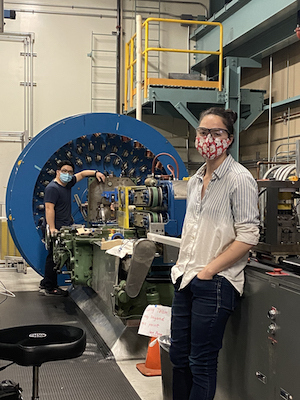
Andy Lin, left, lead cabling technician, and Elizabeth Lee, a quality assurance engineer, install diagnostics on the Rutherford Cabling machine at Berkeley Lab while complying with social-distancing and safety rules. The machine, equipped with dozens of spools of wire, produces high-current superconducting cables for the High-Luminosity LHC Accelerator Upgrade Project. (Credit: Elizabeth Lee/Berkeley Lab)
Note: This article is the final part of a recurring series highlighting Berkeley Lab’s ongoing role in international science collaborations during the COVID-19 pandemic.
While COVID-19 risks had led to a temporary halt in fabrication work on high-power superconducting magnets built by a collaboration of three U.S. Department of Energy (DOE) national labs for an upgrade of the world’s largest particle collider at CERN in Europe, researchers at Lawrence Berkeley National Laboratory (Berkeley Lab) are still carrying out some project tasks.
“Scientific and engineering staff continue to work on project documentation, procurements, and planning,” said Dan Cheng, a Berkeley Lab engineer who oversees magnet assembly activities at Berkeley Lab for the three-lab U.S. Large Hadron Collider (LHC) Accelerator Upgrade Project.
Ian Pong, a scientist in charge of cable fabrication – the other task that is managed by Berkeley Lab – added, “We actually just had a couple of new staff join the team, and we took the opportunity to provide training also.”
The project is part of an international effort to upgrade CERN’s LHC to provide for a larger number of particle collisions – the High-Luminosity LHC (HL-LHC) (see a related video).

Ian Pong, materials project scientist and lab cable task leader, inspects a cable in this 2016 photo. (Credit: Marilyn Sargent/Berkeley Lab)
See other articles in this series:
• In International Physics Collaborations, Working Remotely Is Nothing New
• Daya Bay Reactor Experiment Continues to Generate Data
• Site of LUX-ZEPLIN Dark Matter Search Project Carefully Ramps Up Science Work
• CUORE Underground Experiment in Italy Carries on Despite Pandemic
• DESI Team Prepares for Telescope Instrument’s Restart after Unexpected Shutdown
Soren Prestemon, director of the DOE’s U.S. Magnet Development Program and the Berkeley Center for Magnet Technology, said, “We are developing administrative and engineering controls to allow us to resume our assembly and cabling tasks while still following safe social distancing guidelines. We follow Berkeley Lab guidance on work planning and on-site staff presence.”
Prestemon is deputy division director of technology for the Accelerator Technology and Applied Physics (ATAP) Division at Berkeley Lab. Pong is a staff scientist in ATAP, and Cheng is a member of the Engineering Division.
Cheng noted that the pause in assembly work will inevitably impact the project’s schedule, and social distancing requirements and reduced on-site staffing as Berkeley Lab moves to reopen some activities in a safe and limited way will likely affect efficiency and productivity for a time.
“We expect our operations will take some time ramping up back to full speed,” he said.
Pong agreed, “Although the Lab reopened on June 1, the restart is not a sprint but just the beginning of a marathon.”

Berkeley Lab technicians Ahmet Pekedis, left, and Joshua Herrera assemble the third pre-production magnet for the HL-LHC AUP project. The magnet is expected to ship to Brookhaven National Laboratory for testing in September. (Credit: Dan Cheng/Berkeley Lab)
Some vendors to the U.S. magnet development effort have suffered delays during the pandemic, Cheng noted, though most of the major vendors have been able to continue their work in manufacturing magnet components for the effort.
In all, Berkeley Lab, Fermi National Accelerator Laboratory (Fermilab), and Brookhaven National Laboratory will build and deliver 20 magnets for the HL-LHC project.
Georgio Apollinari, head of the U.S.-based effort and a scientist at Fermilab, noted that the first of these large superconducting magnets that the U.S. labs are supplying for the HL-LHC had been successfully tested in late 2019. “The second production magnet has been completed and was ready to be tested in March 2020 before the impact of COVID-19,” he said.
# # #
Founded in 1931 on the belief that the biggest scientific challenges are best addressed by teams, Lawrence Berkeley National Laboratory and its scientists have been recognized with 13 Nobel Prizes. Today, Berkeley Lab researchers develop sustainable energy and environmental solutions, create useful new materials, advance the frontiers of computing, and probe the mysteries of life, matter, and the universe. Scientists from around the world rely on the Lab’s facilities for their own discovery science. Berkeley Lab is a multiprogram national laboratory, managed by the University of California for the U.S. Department of Energy’s Office of Science.
DOE’s Office of Science is the single largest supporter of basic research in the physical sciences in the United States, and is working to address some of the most pressing challenges of our time. For more information, please visit energy.gov/science.